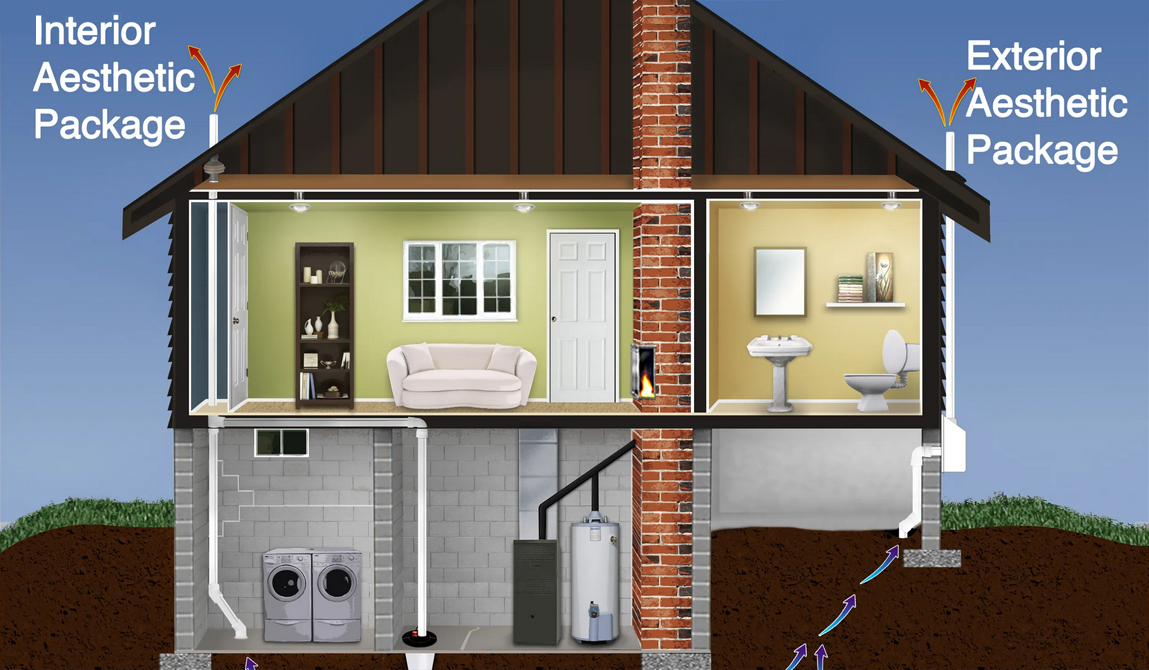Radon Gas – A Concern For Homeowners
Radon Mitigation
Radon levels can be reduced within EPA guidelines using a variety of methods. The choice of method depends on factors such as convenience, appearance, confidence in the system’s performance, and the design and construction of the home. When selecting a mitigation method, it is important to consider the homeowner’s comfort needs. It is recommended to hire a professional mitigation firm that offers competent services at a reasonable cost and provides a guarantee upon completion.

Radon is a radioactive gas produced by decaying radioactive elements such as uranium in the soil. It is tasteless, odorless, and colorless. Prolonged exposure to radon may damage lung tissue and result in lung cancer. A recent study by the Environmental Protection Agency (EPA) estimated that 8 million homes contain potentially dangerous radon levels.
Radon seeps into basements from the soil through cracks in the foundation, sump pumps, or pipes. Inside the house, the lower air pressure draws the gas in, and without adequate ventilation, it can build up and pose a risk to the occupants. However, if adequately ventilated, radon disperses into the outdoor air and ceases to be a health concern.
Detecting and reducing elevated radon levels is a straightforward process. Testing for radon involves placing a small collector in the house for a set period and then sending the collector to a lab for measuring the radon buildup. The easiest testing kit is a charcoal canister that absorbs the gas and shows the level of radon within a few days. It’s important to note that radon levels can vary daily depending on factors like open windows. Some tests take several months to provide an accurate reading. EPA-approved testing kits cost between $20 and $50.
The EPA-approved tests come with instructions for administering the test. The lab results will show the level of pCi/l (picoCuries per liter of air), which is the standard radiation measure. The EPA’s “A Citizen’s Guide to Radon” offers information on understanding radon levels and suggested ways to reduce them. This guide is available for free. You can contact your state EPA office for a copy of the guide.
Dealing with radon involves two main approaches: preventing radon from entering the building or removing radon that is already inside. The solutions for addressing radon can differ in terms of complexity and cost. It’s essential to seek guidance from an EPA-certified radon removal/home improvement firm before pursuing significant mitigation measures.
As a homeowner, it is crucial to be aware of the potential presence of radon. If radon is found, it is necessary to evaluate the level of risk and associated costs before proceeding with mitigation strategies. What does this mean for home buyers and sellers?
Concerns about radon should not deter home purchases since any issues can be addressed promptly. The National Association of Realtors has collaborated with the EPA to educate its members, shape policies, and inform the public about radon. The association’s board of directors has established a radon policy that supports increased efforts by the public and private sectors to assess indoor air quality issues and promote the development of effective and affordable monitoring and mitigation strategies.
The only way to determine if there is a radon issue is by testing your home.
Get a Quote For Radon Mitigation
EXPLANATION OF PROPOSED RADON MITIGATION WORK
Seal Floor & Wall Radon Entry Routes
Caulk and seal openings in the concrete or wood floor and foundation walls where radon can enter the structure.
Seal Crawl Space
Install a gas impervious membrane over the entire soil floor and seal it to the foundation walls with a special adhesive.
Seal Sump
Install a large plastic lid with a built in Plexiglas inspection window over the sump hole and seal airtight so radon does not escape into the structure.
Submembrane Depressurization System
Apply suction under the crawl space membrane using a radon fan, venting the exhaust to the outdoors, at least 10 feet above ground and 10 feet from doors and windows.
Subslab Depressurization System
A/K/A:
Subslab suction
Subslab ventilation
Active soil depressurization
Applying a negative pressure under the sub-floor, concrete or wood, using an in line centrifugal radon fan which draws radon an air through a PVC plastic pipe and vents it to the outdoors, exhausting at least 10 feet above ground and 10 feet from doors and windows. This fan runs constantly at 40 to 90 watts and costs approximately $30.00/year in electricity.
System Failure Indicator
A “U” tube micromanometer (a plastic U shaped clear tube with a red non-toxic liquid inside) mounted on the PVC pipe which indicate air flow in the pipe so that you can see if the system is working.
Diagnostic Smoke Test
A test performed to indicate soil permeability to determine how much suction is needed by the system. It involves drilling two or more small holes in the concrete floor, attaching a vacuum to one hole and shooting a chemical smoke in the other(s). If the smoke is pulled down the hole by the vacuum, the permeability is good, therefore a high suction system is not needed, only a low suction system is necessary.
